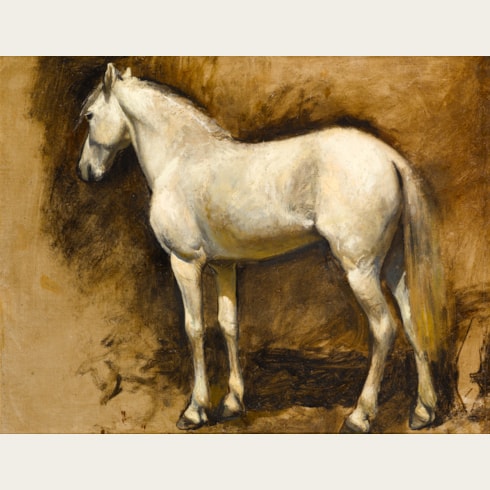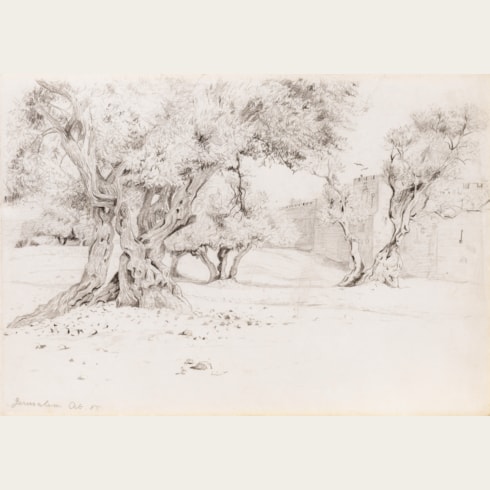Edwin Lord WEEKS
(Boston 1849 - Paris 1903)
Study of a Standing Man
Sold
Oil on canvas.
Signed and dedicated To my cousin Sophie / E. L. Weeks at the lower left.
339 x 234 mm. (13 4/8 x 9 1/4 in.)
Signed and dedicated To my cousin Sophie / E. L. Weeks at the lower left.
339 x 234 mm. (13 4/8 x 9 1/4 in.)
The present oil sketch is a study for the prominent figure in the foreground of Week’s large canvas Powder Play: City of Morocco, Outside the Walls, painted in Paris around 1880-18823, after the artist’s return from several years in Morocco. The painting depicts a scene outside the walls of a Moroccan city, possibly the ancient capital of Marrakech, with the snow-capped Atlas mountains in the distance. A contingent of mounted troops parades before the Sultan, sitting on horseback under a red canopy, while in the foreground a smaller group of mounted warriors show off their marksmanship.
As Ellen Morris notes of the painting, ‘The result of the composition is a painting of panoramic impact and a rare example of Weeks’ deftness in painting broad landscapes…[The] generally subdued palette of the work is offset by the finely-drafted and brightly-colored foreground figures, and some judiciously-placed color accents in the spectators and the line of mounted troops. The painting exhibits a strong sense of naturalism in both its composition and the superb modelling of the figures.’
As Ellen Morris notes of the painting, ‘The result of the composition is a painting of panoramic impact and a rare example of Weeks’ deftness in painting broad landscapes…[The] generally subdued palette of the work is offset by the finely-drafted and brightly-colored foreground figures, and some judiciously-placed color accents in the spectators and the line of mounted troops. The painting exhibits a strong sense of naturalism in both its composition and the superb modelling of the figures.’
Little is known of Edwin Lord Weeks’s artistic training before 1874, when he enrolled in the studio of Léon Bonnat in Paris. By this time, however, he had already visited Morocco, Egypt, Palestine and Syria, and had exhibited several paintings inspired by this journey in his native city of Boston in 1874. His exposure to these exotic lands was to stand him in good stead with Bonnat and his friend Jean-Léon Gérôme, both of whom encouraged Weeks’s interest in Orientalist subjects. Weeks made his home in Paris, where he exhibited with great success at the annual Salons. He continued to travel to the Near East and North Africa, spending a considerable amount of time in Morocco between 1878 and 1880. He was one of the few Westerners to visit Rabat, Salé and Marrakech, and nearly died from typhoid fever. His Salon debut, in 1878, was with a painting of a Moroccan camel driver, and he continued to show Moroccan subjects for several years thereafter. (He also published an extensive account of his travels in Morocco in an article entitled ‘Two Centuries of Moorish Art’, which appeared in the April 1901 issue of Scribner’s Magazine.)
Between 1882 and 1893 Weeks made three long trips to India, taking not only paints and sketchbooks but also a camera, with which he recorded the architecture and landscape of the places he visited. In 1892 Weeks and a journalist, Theodore Child, travelled overland from Trebizond, on the Black Sea, to India, on an assignment sponsored by Harper’s Magazine. The artist produced numerous illustrations to supplement Child’s written dispatches, and eventually published a diary of this epic journey as From the Black Sea to India in 1896. Weeks remained in India for two years before returning home to Paris, where he was to live until his death. His views of India and Indian life proved extremely popular with French and American collectors, and became his particular specialty. He died in 1903 at the age of fifty-four, possibly from an illness contracted in India.
When the contents of his studio were dispersed at auction two years later, it was noted of Weeks that ‘Where the ordinary traveller has observed only squalor and misery, he has seen the enchanting glories of sunlight and shadow and the bewitching contrasts of color in costume, in architecture and in landscape. The native Indian with his mud hut, his chattie and his charpoy, has been to him but an episode to accentuate more strongly the sumptuousness of other phases of Oriental life...’
Provenance
A gift from the artist to his cousin Sophie, according to the artist’s inscription at the lower left
Private collection, Rhode Island.
Literature
To be included in the forthcoming Edwin Weeks catalogue raisonné in preparation by Dr. Ellen Morris.








